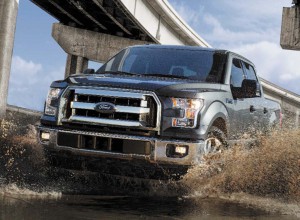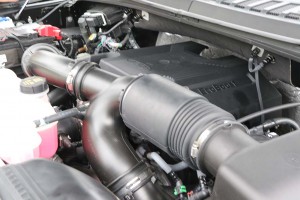Ford Motor Co.’s costly program to develop the world’s first 10-speed automatic transmission is beginning to pay off, especially for shoppers looking to buy the maker’s 2017 F-150 pickup.
Ford says the gearbox will help it yield an 11% increase in mileage on four-wheel-drive models using Ford’s 3.5-liter EcoBoost V-6 turbo engine. The 2017 F-150 package will yield an average 20 miles per gallon in the EPA’s Combined cycle, up from 18 mpg with the 2016 pickup.
The new 10-speed was jointly developed by Ford and General Motors and the transmission will eventually be added to a wide variety of different products in each of their line-ups. GM’s first application will come with next year’s launch of the Chevrolet Camaro ZL1.
Automakers around the world have been racing to add more gears to their automatic – and, even to some of their manual – transmissions. The primary reason is fuel economy. Theoretically, the more gears the closer an engine can operate to its sweet spot, the RPM range in which it is most efficient given the moment’s demands.
Where six-speed gearboxes were relatively rare at the beginning of the millennium, they are now almost out-of-date, more and more vehicles shifting to seven-, eight- and even nine-speed transmissions. Several other automakers, including Toyota, are now working on 10-speed packages, and Honda has even filed a patent application in Japan for an 11-speed.
(How many gear are too many gears? Click Here for the story.)

Ford's new 10-speed transmission provides a significant fuel savings, especially when tied to the 3.5-liter EcoBoost V6.
An alternative is the CVT, or continuously variable transmission, which uses a belt system to find that sweet spot, rather than so-called step gears. But CVTs generally cannot handle the hefty torque demands of a pickup or muscle car, and have certain drive characteristics that don’t always satisfy consumers.
But developing a new transmission is a costly venture and in a rare move, two erstwhile rivals decided to team up to help cut costs. They worked on the basic architecture of the 10-speed, Ken Norris, the leader of Ford’s development team, told TheDetroitBureau.com, but then split off to finish the process. Each maker came up with its own software and hydraulic control systems, the components that help define the character of the shifts and overall performance.
(Ford, Trump aim for truce. For more, Click Here.)
“This is a Ford-specific transmission,” Norris said, “specifically designed and developed for the Ford F-150. This won’t bolt to a GM engine and vice versa.”
Beyond delivering solid fuel economy improvements, a key goal for Ford was improving drivability. That’s been a major problem with some of the latest transmissions, such as the nine-speed used by Fiat Chrysler Automobiles in a number of current products.
The challenge is to ensure the gearbox finds the optimum gear and avoids constant hunting-and-seeking from one gear to the next. Shifts, meanwhile, need to be virtually transparent. Ford doubled the number of lines of code used for the 10-speed, from 500,000 for the old gearbox, to 1 million, according to Norris.
An 11% increase in fuel economy is significant, as was the gain Ford made by shifting from a traditional, steel-bodied design to the “aluminum-intensive” construction of the latest F-150 family. But the timing may not be ideal. When the 10-speed project was launched, the country was coming out of the Great Recession, and fuel prices were spiking up to $4 a gallon. Now, however, motorists in many parts of the country are paying as little as $1.80 a gallon.
That said, a sizable share of pickups are purchased for fleet use, and commercial operators watch operating costs down to the fraction of a penny, so even in an era of cheap fuel, an 11% increase can’t be ignored. And if – or, more likely, when — fuel prices do start spiking again, Ford could have a significant advantage over the competition.
(Jeep rushing out fix for eShifter linked to Star Trek actor’s death. Click Here for more.)


